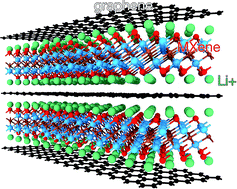当前位置:
X-MOL 学术
›
J. Mater. Chem. A
›
论文详情
Our official English website, www.x-mol.net, welcomes your feedback! (Note: you will need to create a separate account there.)
MXenes/graphene heterostructures for Li battery applications: a first principles study†
Journal of Materials Chemistry A ( IF 11.9 ) Pub Date : 2018-01-02 00:00:00 , DOI: 10.1039/c7ta09001c Yierpan Aierken 1, 2, 3, 4 , Cem Sevik 5, 6, 7, 8, 9 , Oğuz Gülseren 1, 9, 10, 11 , François M. Peeters 1, 2, 3, 4 , Deniz Çakır 1, 2, 3, 4, 12
Journal of Materials Chemistry A ( IF 11.9 ) Pub Date : 2018-01-02 00:00:00 , DOI: 10.1039/c7ta09001c Yierpan Aierken 1, 2, 3, 4 , Cem Sevik 5, 6, 7, 8, 9 , Oğuz Gülseren 1, 9, 10, 11 , François M. Peeters 1, 2, 3, 4 , Deniz Çakır 1, 2, 3, 4, 12
Affiliation

|
MXenes are the newest class of two-dimensional (2D) materials, and they offer great potential in a wide range of applications including electronic devices, sensors, and thermoelectric and energy storage materials. In this work, we combined the outstanding electrical conductivity, that is essential for battery applications, of graphene with MXene monolayers (M2CX2 where M = Sc, Ti, V and X = OH, O) to explore its potential in Li battery applications. Through first principles calculations, we determined the stable stacking configurations of M2CX2/graphene bilayer heterostructures and their Li atom intercalation by calculating the Li binding energy, diffusion barrier and voltage. We found that: (1) for the ground state stacking, the interlayer binding is strong, yet the interlayer friction is small; (2) Li binds more strongly to the O-terminated monolayer, bilayer and heterostructure MXene systems when compared with the OH-terminated MXenes due to the H+ induced repulsion to the Li atoms. The binding energy of Li decreases as the Li concentration increases due to enhanced repulsive interaction between the positively charged Li ions; (3) Ti2CO2/graphene and V2CO2/graphene heterostructures exhibit large Li atom binding energies making them the most promising candidates for battery applications. When fully loaded with Li atoms, the binding energy is −1.43 eV per Li atom and −1.78 eV per Li atom for Ti2CO2/graphene and V2CO2/graphene, respectively. These two heterostructures exhibit a nice compromise between storage capacity and kinetics. For example, the diffusion barrier of Li in Ti2CO2/graphene is around 0.3 eV which is comparable to that of graphite. Additionally, the calculated average voltages are 1.49 V and 1.93 V for Ti2CO2/graphene and V2CO2/graphene structures, respectively; (4) a small change in the in-plane lattice parameters (<1%), interatomic bond lengths and interlayer distances (<0.5 Å) proves the stability of the heterostructures against Li intercalation, and the impending phase separation into constituent layers and capacity fading during charge–discharge cycles in real battery applications; (5) as compared to bare M2CX2 bilayers, M2CX2/graphene heterostructures have lower molecular mass, offering high storage capacity; (6) the presence of graphene ensures good electrical conductivity that is essential for battery applications. Given these advantages, Ti2CO2/graphene and V2CO2/graphene heterostructures are predicted to be promising for lithium-ion battery applications.
中文翻译:

锂电池应用中的MXenes /石墨烯异质结构:第一个原理研究†
MXenes是最新的一类二维(2D)材料,它们在包括电子设备,传感器以及热电和储能材料在内的广泛应用中具有巨大的潜力。在这项工作中,我们结合了石墨烯与MXene单层(M 2 CX 2,其中M = Sc,Ti,V和X = OH,O)的出色电导率(这对于电池应用至关重要),以探索其在锂电池中的潜力应用程序。通过第一原理计算,我们确定了M 2 CX 2的稳定堆叠配置/石墨烯双层异质结构及其Li原子的嵌入,通过计算Li的结合能,扩散势垒和电压来实现。我们发现:(1)对于基态堆叠,层间结合力强,而层间摩擦力小;(2)与OH封端的MXenes相比,由于H +诱导排斥Li原子,因此Li与O封端的单层,双层和异质结构MXene系统结合更牢固。由于带正电的锂离子之间增强的排斥相互作用,锂的结合能随着锂浓度的增加而降低;(3)Ti 2 CO 2 /石墨烯和V 2 CO 2/石墨烯异质结构表现出大的Li原子结合能,使其成为电池应用中最有希望的候选者。当完全充满Li原子时,Ti 2 CO 2 /石墨烯和V 2 CO 2 /石墨烯的结合能分别为-1.43 eV / Li原子和-1.78 eV / Li原子。这两个异质结构在存储容量和动力学之间表现出很好的折衷。例如,Li在Ti 2 CO 2 /石墨烯中的扩散势垒约为0.3 eV,与石墨相当。另外,对于Ti 2 CO 2 /石墨烯和V 2 CO 2,计算出的平均电压为1.49 V和1.93 V/石墨烯结构;(4)面内晶格参数(<1%),原子间键长和层间距离(<0.5Å)的微小变化证明了异质结构对Li嵌入的稳定性以及即将发生的相分离到组成层和容量中在实际电池应用中的充放电循环中会褪色;(5)与裸露的M 2 CX 2双层相比,M 2 CX 2 /石墨烯异质结构具有较低的分子量,具有高的存储容量;(6)石墨烯的存在可确保良好的导电性,这对于电池应用至关重要。鉴于这些优势,Ti 2 CO 2 /石墨烯和V 2 CO预测2 /石墨烯异质结构有望用于锂离子电池。
更新日期:2018-01-02
中文翻译:

锂电池应用中的MXenes /石墨烯异质结构:第一个原理研究†
MXenes是最新的一类二维(2D)材料,它们在包括电子设备,传感器以及热电和储能材料在内的广泛应用中具有巨大的潜力。在这项工作中,我们结合了石墨烯与MXene单层(M 2 CX 2,其中M = Sc,Ti,V和X = OH,O)的出色电导率(这对于电池应用至关重要),以探索其在锂电池中的潜力应用程序。通过第一原理计算,我们确定了M 2 CX 2的稳定堆叠配置/石墨烯双层异质结构及其Li原子的嵌入,通过计算Li的结合能,扩散势垒和电压来实现。我们发现:(1)对于基态堆叠,层间结合力强,而层间摩擦力小;(2)与OH封端的MXenes相比,由于H +诱导排斥Li原子,因此Li与O封端的单层,双层和异质结构MXene系统结合更牢固。由于带正电的锂离子之间增强的排斥相互作用,锂的结合能随着锂浓度的增加而降低;(3)Ti 2 CO 2 /石墨烯和V 2 CO 2/石墨烯异质结构表现出大的Li原子结合能,使其成为电池应用中最有希望的候选者。当完全充满Li原子时,Ti 2 CO 2 /石墨烯和V 2 CO 2 /石墨烯的结合能分别为-1.43 eV / Li原子和-1.78 eV / Li原子。这两个异质结构在存储容量和动力学之间表现出很好的折衷。例如,Li在Ti 2 CO 2 /石墨烯中的扩散势垒约为0.3 eV,与石墨相当。另外,对于Ti 2 CO 2 /石墨烯和V 2 CO 2,计算出的平均电压为1.49 V和1.93 V/石墨烯结构;(4)面内晶格参数(<1%),原子间键长和层间距离(<0.5Å)的微小变化证明了异质结构对Li嵌入的稳定性以及即将发生的相分离到组成层和容量中在实际电池应用中的充放电循环中会褪色;(5)与裸露的M 2 CX 2双层相比,M 2 CX 2 /石墨烯异质结构具有较低的分子量,具有高的存储容量;(6)石墨烯的存在可确保良好的导电性,这对于电池应用至关重要。鉴于这些优势,Ti 2 CO 2 /石墨烯和V 2 CO预测2 /石墨烯异质结构有望用于锂离子电池。

























 京公网安备 11010802027423号
京公网安备 11010802027423号